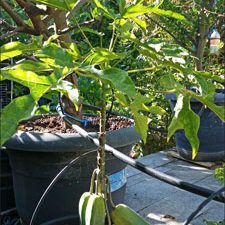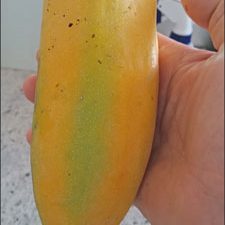Vasconcellea (Carica) X heilbornii (pentagona)
Babaco, mountain papaya
Origin
The Andean highlands of Ecuador at elevations of 1000-2600m. It is now grown in a number of other countries and regions, including Israel, Italy, Spain, South Africa, California, Australia and New Zealand.
Climate
Optimal conditions for growing are a cool sub-tropical or warm temperate climate, 14-27°C with 800-1400mm yearly precipitation, relative humidity of 80% and 4-5hrs of sunlight/d. More prolonged or intense sunlight and low humidity will cause sunburn. Although it can withstand light infrequent frosts, it may lose all its foliage and bear poorly.
Plant Description
It is a small soft-wooded semi-perennial tree that can grow rapidly to 3-4m with very little branching and a trunk marked by fallen leaf scars. Vigour is indicated by trunk thickness. There is a shallow fleshy taproot that may attain a diameter of 30-40cm and have many lateral roots. The spiral semi-evergreen palmate glabrous green leaves, lighter colour underneath and 5-7-lobed, have a long hollow petiole and prominent venation. Depending on cultural conditions, leaves may last for several months before abscising. Copious latex is produced when tissue is damaged.
Relatives
Babaco is a natural sterile hybrid in the small dicotyledenous family Caricaceae, with papaya (Carica papaya) being its most commercially important relative. It has been assigned a variety of botanical names in the past with Carica X pentagona probably being the most widely used. However, the most recent morphological and molecular taxonomic work has placed babaco in the genus Vasconcellea, the largest genus in the family with 21 species; some of the others in this genus are edible, but usually require some cooking to become more palatable. Hybrid parental lineage is still unclear, but a common maternal ancestor with V. weberbaueri seems likely. Within the family, papaya and babaco are only distantly related.
Soils
Although it can grow in quite a wide range of soils and conditions, sandy loam with a pH of 6-7 and good organic content (>3%) is preferred. Good drainage is required to avoid root problems.
Propagation
As the plants are sterile, this is usually done by cuttings (10 X 2cm). Cuttings should be allowed to dry out in a cool area until latex flow stops and some callus formation has begun. They should then be treated with an antifungal agent and rooting hormone and placed in the ground or in pots (22°C and 90% humidity) when they may take 5-7 weeks to strike. Other Vasconcellea species are sometimes used as grafting rootstocks to confer favourable properties such as increased vigour, pest resistance and cold tolerance.
Cultivars
Cultivated babaco is propagated vegetatively, but in endemic regions where other cross-compatible Vasconcellea species exist (wild or cultivated), they can act as pollen donors for the few seeds sometimes produced in babaco to produce different clones; these are difficult to source in Australia. However environmental and cultural conditions can produce some variation in fruit properties such as flavour and size, and there is a New Zealand clone that is particularly sweet. If the economic importance of babaco ever increases substantially, classical breeding studies (difficult) together with non-conventional programs (eg embryo rescue, gene transfer/editing technology) will no doubt provide the means to markedly improve species traits.
Flowering and Pollination
The flowering habit is indeterminate. Axillary pistillate flowers (3-4cm long) are bell-shaped and usually solitary with five yellowish petals (2.5-3.5cm) and dark green sepals. There are no staminate flowers and no need for pollination as fruit are usually formed parthenocarpically.
Cultivation
The soft-wooded roots have difficulty penetrating heavy or compacted soils. As a small tree, they can be closely planted (1.5m X 1.5m) or put in 50L pots, or grown in greenhouses in cooler or extremely hot/dry climates. Under favourable conditions, new plants can be in production mode after only 1-2 seasons, with impressive yields exceeding those of papaya. Frequent watering is required in our predominantly sandy soils, along with a regular supply (every 2-3 months) of NPK including trace elements.
Wind Tolerance
Trees are sensitive to wind because of the shallow root system. Leaf damage may also occur.
Pruning
Any base side shoots should be trimmed off, leaving one major trunk for maximising fruit size and only one other to grow into a main stem when the original is losing vigour after 3-4 seasons. Spent stems should be cut back to the base and can be used as cuttings for propagation.
The Fruit
A five-sided drooping berry on a long peduncle (8-15cm), rounded at the proximal end and acute at the apex, that can grow to 30 X 15cm and 0.5-2kg. Seeds are usually absent but occasionally there may be a few. The green skin turns yellow on ripening (decreasing chlorophyll and increasing carotenoids), and fruit ripen over 5-8mths in the order they were formed from the base to the apex of the tree, with the largest fruit forming lower down on the trunk. While the whole fruit is edible, it’s usually only the white/cream-coloured mesocarp (80-85% of the fruit) below the pericarp and separate from the central spongy flesh that is preferred. The acid flesh is pleasantly aromatic but low in sugar (3-6%, comparable to eg tomatoes). The latex of unripe fruit contains proteolytic and lipolytic enzymes that are many times higher than in papaya.
Fruit Production and Harvesting
Babaco can be incredibly productive and precocious under ideal conditions, with commercial yields of 200T /Ha being reported for 2-3 year old plants. This compares very favourably with more conventional fruit tree species where the juvenility period can be many years and then full production may only be achieved several years thereafter. Like papaya if winter conditions are not too severe, plants can crop throughout the year and may require support if they’re carrying a large number of fruit. They are usually harvested for 3-4 years before coppicing. Fruit should be picked using secateurs, leaving a short length of peduncle attached to minimise fungal rots during storage. Harvest period is staggered as fruit mature upwards on the tree. Home growers can optimise flavour by delaying picking till almost the whole fruit has turned yellow, whereas commercial growers have to harvest much earlier to allow for transport and marketing delays. If picked when mature (>10% yellow) it might take 2-3 weeks to fully ripen at room temperature; as a climacteric fruit, ethylene will speed this process. Shelf life of fully ripe fruit at >10°C is 2-4 weeks, but chilling injury will result if kept below 6°C.
Fruit Uses
Often consumed fresh when completely ripe, but also as an ingredient in juice, jams, marmalade, cakes, puddings, sauces etc. Because of the low sugar content, some people like to add some honey or a sprinkle of sugar to improve the taste.
Pests and Diseases
Numerous pests and diseases have been reported to attack babaco. These include aphids, mites, thrips, nematodes, root rots (eg Phytophthora, Fusarium, Pythium), powdery mildew and anthracnose. As a high density species, weeds competing for water and nutrients must be kept under control.
Comments
This is an ideal species for the home grower with little space as it’s a small tree with a small footprint, and it can easily be grown in pots. Provided you like the taste, ensure adequate water and nutrient supply and use an open high organic content soil with good drainage, you’ll be rewarded with an enviable and regular supply of this unusual fruit.

